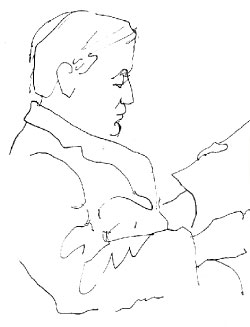 |
Sketch by Milton Glaser, 1967.
|
As told to Gail Sheehy.
The first thing I did when I got to New York City on the day I was discharged from the Navy in the spring of 1946, after I took a train from Bainbridge, Maryland, to Penn Station, was to hail a taxi, and direct the cabbie to take me to the street of jazz—52nd Street off Sixth Avenue—where clubs lined both sides of the street. I ducked into one called the Four Deuces and headed straight for the men’s room, where I literally ripped off my Navy blouse and pulled off my bell-bottoms and changed into the one civilian suit I had from college, a gray-flannel pinstripe, because I wanted to be part of New York.
My earliest concept of New York came on a visit to my grandparents’ home in Joplin, Missouri. I read the whole series of Horatio Alger books that my grandfather, Henry Clay Felker, had kept from my father’s childhood. They always featured young poverty-stricken boys, often immigrants, who sold newspapers on the streets of New York and had absolutely nothing but Luck and Pluck—the name of a typical Alger book.
I identified with those young guys in the Horatio Alger stories because I was an “immigrant” from the Midwest and because I didn’t have any money in that summer of ’46. My take-home pay was $42 a week, and out of that, I had to pay $20 a week for rent plus transportation and food. I ate in cafeterias and lived in one room on 23rd Street between Lexington and Third.
I couldn’t go back to Duke University until fall. So my father, who was managing editor of The Sporting News, got me a job selling ads for the Sporting Goods Dealer, a catalogue of sports equipment. Many of the dealers were located along lower Broadway. So I began at the Battery and worked my way up Broadway, meandering to explore the side streets. Walking was the only entertainment I could afford. Out of curiosity and fantasy, I began cataloguing the characters of the city, thinking of Walt Whitman. That was the way I learned New York.
My first publishing venture—I was about 8 years old—was the Greeley Street News, a neighborhood paper I sold for five cents. My inspiration for what became called, in the sixties, “the New Journalism” came in the stacks of the Duke University library, where I pored over the 100-year-old journalism of Horace Greeley’s famous newspaper, the Civil War–era New York Tribune. Greeley saw news as narrative. I read story after story about the Civil War, written by soldiers who were living it and wrote with the vivid detail of novelists.
Back in 1946, sportswriters were my journalistic heroes. To me, the most outstanding columnist in the United States, by far, was Red Smith. I knew about another famous sportswriter who had gotten into the ring with Jack Dempsey to see what it was like. So, in imitation of him, I entered the Golden Gloves boxing competition on the naval base.
Of course, I had no training, I had only 130 pounds of flesh stretched over my gangly six-foot frame. The first night I was so jazzed up, I went after my opponent like a windmill and won the three-round match. The next night, I was up against a left-handed boxer. Since I knew nothing about fighting, I was a pathetic punching bag. My opponent hit me in the stomach so hard I thought he’d punctured my intestines. My legs sagged, I was about to hit the canvas, when I saw, out of the corner of my eye, the photographer I had assigned to cover the fights. The guy was about to snap a picture of me being knocked flat. The shame of having to see myself on the canvas, on the front page of the base newspaper, was too much. So I managed to stay on my feet and continue to offer my opponent a ready punching bag.
Another early fantasy of mine about New York came from reading Esquire. I pictured the editors going out dressed in black tie with beautiful women on their arms. They would walk into ‘21’ and into the corridor of glamour and power of New York. Much later, when I actually went to work at Esquire, I realized the world it created in its pages had come out of the imagination of its original editor, Arnold Gingrich. I wanted to become part of that world, too. I wanted to be a New York editor.
